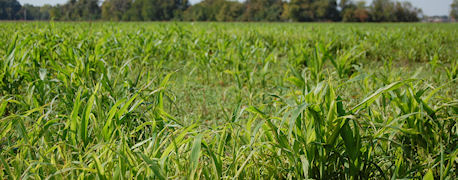October 11, 2012

The relatively early beginning to corn harvest provided a good environment for the emergence of volunteer corn, says University of Illinois associate professor of weed science Aaron Hager.
"Emerged volunteer corn at this time of year is normally not a problem because the plants will winterkill," Hager adds. "However, if a killing frost does not occur soon, these volunteer plants could be an impediment to farmers who would like to sow wheat this fall."
To provide a better environment for small grain establishment, volunteer corn plants should be controlled before sowing. Preplant tillage is effective. But what about using a herbicide to control established plants?
Glyphosate is very effective for controlling existing stands of sensitive corn. There is no waiting interval between application and sowing small grains, but overall control may be improved if at least 24 hours elapse between application and planting.
Glyphosate will not control glyphosate-resistant volunteer corn. Alternative herbicides such as Gramoxone SL should be used. Control tends to improve if it is applied to corn plants with at least three leaf collars. Poast, Poast Plus, Fusion, Fusilade, Select, and Assure II are effective against volunteer corn (including glyphosate-resistant volunteer corn). However, Hager warns, the interval that must elapse between application and rotation to fall-seeded wheat is too long.
These intervals range from 30 (Poast, Poast Plus, Select, Select Max) to 60 (Fusion, Fusliade), to as many as 120 (Assure II) days. Targa, which does allow applications prior to wheat emergence, is an exception. The label warns, however, that applications made within 7 days of sowing can harm wheat.
"If you plan to sow wheat in corn or soybean fields where one or more herbicides were applied in 2012, be sure to check the herbicide labels for information on rotational intervals," Hager advises. "Most rotational intervals are based solely on time, but rotational intervals for some herbicides might need to be lengthened, depending on other factors such as soil pH values or droughty conditions."
You May Also Like




